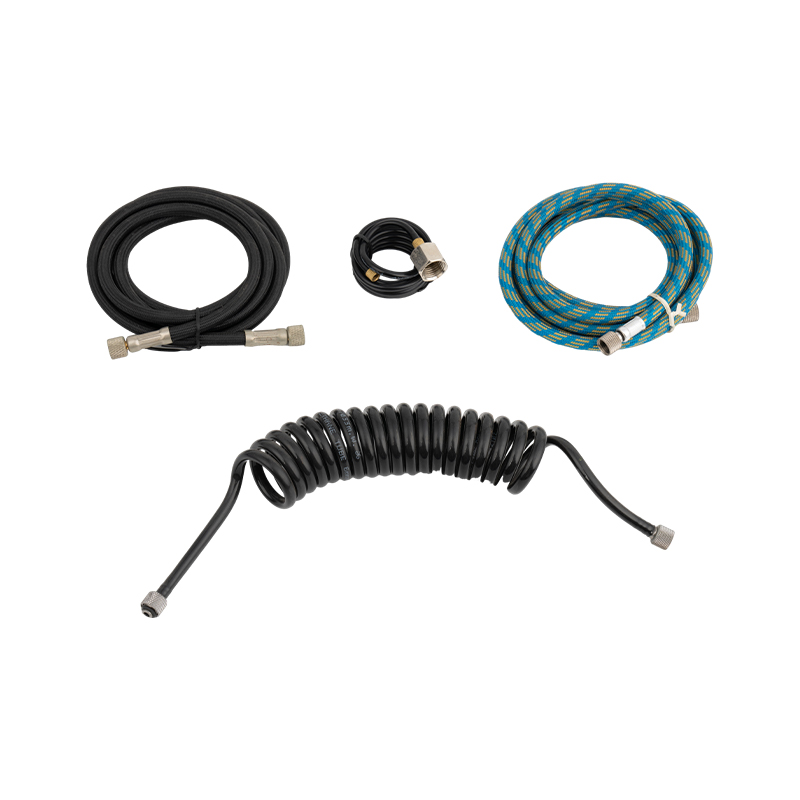TM134 Double action siphon feed airbrush
Cat:Airbrush
Features self-centering drop-in nozzle for outstanding alignment and even control through the spray range Spray light to heavy viscosity paint materia...
See DetailsAir Hose Leakage
Leakage is a common problem with air hoses over long periods of use. Leakage is typically caused by aging, wear, or loose joints. Leakage not only reduces air pressure and affects equipment operation, but can also waste energy and pose safety risks. When a leak occurs, promptly inspect the hose surface and joints for damage or looseness, and repair or replace them.
Air Hose Rupture or Crack
Air hoses are prone to rupture or cracking when subjected to excessive stretching, bending, or external impact. This type of failure can obstruct or interrupt gas flow, and in severe cases, affect the stability of the entire pneumatic system. Hose ruptures often occur in locations with frequent movement or friction. Therefore, design and installation should avoid excessive bending and friction to extend the hose's life.
Loose or Falling Connectors
If air hose connections are not properly installed or secured, they can easily become loose or even fall off. These problems can lead to a drop in air pressure, gas leaks, or even hose detachment, potentially causing safety hazards. Regularly checking that connections are securely fastened is a key measure to prevent these problems. Selecting fittings of appropriate specifications and quality is also crucial for ensuring connection reliability.
Internal Hose Blockage
Dust, oil, or impurities can accumulate inside the hose, causing blockage and airflow obstruction. Blockages can affect the equipment's pneumatic performance and reduce operating efficiency. Blockages are often difficult to detect visually, so regular internal cleaning or replacement of the hose is necessary. Hose maintenance should be strengthened, especially in environments with high dust levels or where lubricants are frequently used.

Hose Aging and Hardening
Prolonged exposure to UV rays, high temperatures, or chemical media can cause air hose materials to age and harden. Aged hoses lose their elasticity, becoming brittle and prone to cracking and breaking during use. Hardening reduces their flexibility and increases the risk of breakage. To avoid these problems, select hoses of suitable material for the operating environment and regularly replace them.
Damage Caused by Improper Bend Radius
A narrow bend radius during air hose operation can cause additional stress on the hose, potentially damaging the inner or outer material. Prolonged, improper bending not only affects airflow but also shortens hose life. During design and installation, adhere to hose bend radius specifications and avoid sharp bends and folds. Using auxiliary devices such as brackets or conduits can effectively reduce bending stress.
Hose Surface Wear
Air hoses are susceptible to wear during operation due to friction with surrounding equipment or surfaces. Surface wear can weaken the hose's protective coating, increasing the risk of breakage and compromising the hose's overall strength. Regularly inspect for wear and take preventative measures if any abnormalities are detected, such as adding protective covers or adjusting the hose's routing.
Failures Caused by Temperature Fluctuations
Air hoses can contract or expand in environments subject to drastic temperature fluctuations, leading to loose connections or hose deformation. Temperature stress can also cause material fatigue and accelerate hose damage. Selecting hose materials with temperature resistance that meets the operating environment's requirements and implementing temperature protection measures can help minimize the occurrence of these types of failures.
Hose Bursts Due to Insufficient Pressure Resistance
If a hose is subjected to pressure exceeding its designed capacity during use, it is prone to bursting. Insufficient pressure resistance may result from improper selection or large pressure fluctuations. Hose specifications and materials should be appropriately selected based on the actual operating pressure to avoid overloading and ensure a safe and stable pneumatic system.
Improper maintenance exacerbates the aforementioned problems
Failure to maintain air hoses promptly or using improper methods can exacerbate these problems. For example, insufficient lubrication, incomplete cleaning, or improper installation can accelerate hose damage. Establishing a sound maintenance system and regular inspections and maintenance are key to extending the life of air hoses.
Common air hose problems and their corresponding solutions
| Fault Type | Possible Causes | Treatment Measures | Prevention Suggestions |
|---|---|---|---|
| Leakage | Material aging, poor sealing | Replace hose or sealing parts | Regular inspection to ensure sealing integrity |
| Cracking or Rupture | Excessive stretching, bending, external impact | Replace hose | Avoid sharp bends and excessive stretching |
| Loose Connection | Improper installation, insufficient fastening | Reinstall and tighten | Use appropriate fittings, check regularly |
| Internal Blockage | Accumulation of dust, oil | Clean or replace hose | Maintain clean environment, regular maintenance |
| Aging and Hardening | Exposure to UV, high temperature, chemical media | Replace hose | Select materials suitable for environment, replace regularly |
| Improper Bending Radius | Too small bending radius | Adjust installation method | Follow bending radius guidelines, use supports |
| Surface Wear | Friction | Add protective sleeves, adjust hose routing | Regular inspection, apply protective measures |
| Temperature Effects | Drastic temperature changes | Ensure tight connections, use heat-resistant hose | Proper material selection, temperature protection |
| Insufficient Pressure Resistance | Incorrect selection, overpressure | Replace with suitable hose | Choose based on pressure, avoid overpressure |
| Improper Maintenance | Long maintenance intervals, wrong methods | Standardize maintenance, timely inspections | Establish maintenance plan, train operators |
Contact Us